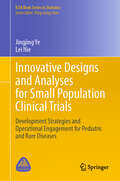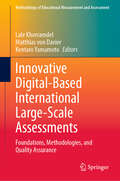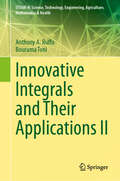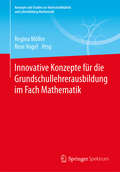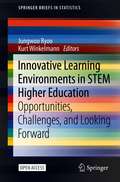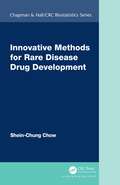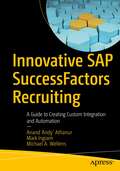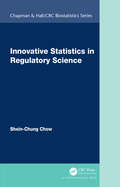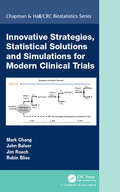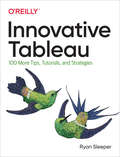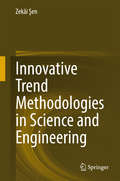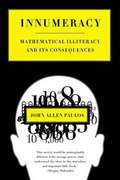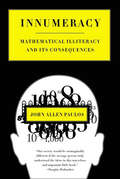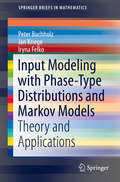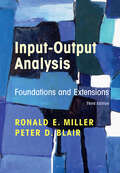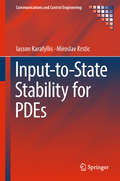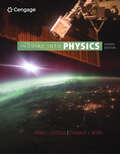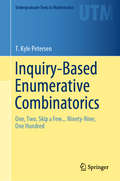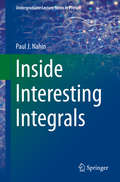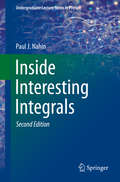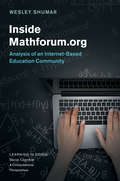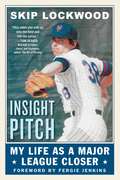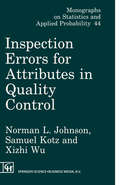- Table View
- List View
Innovative Designs and Analyses for Small Population Clinical Trials: Development Strategies and Operational Engagement for Pediatric and Rare Diseases (ICSA Book Series in Statistics)
by Jingjing Ye Lei NieThis book discusses a multidisciplinary and multi-stakeholder collaborative approach to small population clinical trials. It provides and illustrates a systematic framework that depends upon a collaborative infrastructure between the patient community, patient advocacy groups, researchers and investigators, pharmaceutical companies, global regulatory agencies, and customers. The book also highlights the considerations of natural history and patient registry, diagnostic criteria determination, identification of clinically meaningful endpoints, and global regulatory guidance. The authors detail the nuances of clinical trial design as specific to small population disease, drawing from real examples.
Innovative Digital-Based International Large-Scale Assessments: Foundations, Methodologies, and Quality Assurance (Methodology of Educational Measurement and Assessment)
by Matthias Von Davier Kentaro Yamamoto Lale KhorramdelThis edited volume provides a comprehensive overview of the technology-driven innovations that have transformed National and International Large-Scale Assessments over the past decade, along with the research and considerations that have accompanied these changes. It documents the groundwork for ongoing innovations and explores future directions as these assessments continue to evolve. While the impact of technology on education and assessments is difficult to predict, best practices and emerging principles for transitioning from paper-based to digital formats can be described. The volume offers guidelines and examples from experts who have transitioned assessments like PISA, PIAAC, TIMSS, PIRLS, and NAEP into the digital era. It also highlights research on digital-based assessments, showcasing new insights from log file and process data, as well as innovative domains.
Innovative Integrals and Their Applications II (STEAM-H: Science, Technology, Engineering, Agriculture, Mathematics & Health)
by Bourama Toni Anthony A. RuffaIn its second installment, Innovative Integrals and Their Applications II explores multidimensional integral identities, unveiling powerful techniques for attacking otherwise intractable integrals, thus demanding ingenuity and novel approaches. This volume focuses on novel approaches for evaluating definite integrals, with the aid of tools such as Mathematica as a means of obtaining useful results. Building upon the previous methodologies, this volume introduces additional concepts such as interchanging the order of integration, permutation symmetry, and the use of pairs of Laplace transforms and Fourier transforms, offering readers a comprehensive array of integral identities. The content further elucidates the techniques of permutation symmetry and extends the multivariate substitution approach to integrals with finite limits of integration. These insights culminate in a collection of integral identities involving gamma functions, incomplete beta functions, Bessel functions, polylogarithms, and the Meijer G-function. Additionally, readers will encounter applications of error functions, inverse error functions, hypergeometric functions, the Lambert W-function, elliptic integrals, Jacobi elliptic functions, and the Riemann zeta function, among many others, with a focus on their relevance in various scientific disciplines and cutting-edge technologies. Each chapter in this volume concludes with many interesting exercises for the reader to practice. A key tenet is that such approaches work best when applied to integrals having certain characteristics as a starting point. Most integrals, if used as a starting point, lead to no result at all, or lead to a known result. However, there is a special class of integrals (i.e., innovative integrals), which, if used as a starting point for such approaches, lead to new and useful results, and can also enable the reader to generate other new results that do not appear in the book. The intended readership includes science, technology, engineering, and mathematics (STEM) undergraduates and graduates, as well as STEM researchers and the community of engineers, scientists, and physicists; most of these potential readers have experienced the importance and/or the applications of integration from finding areas, volumes, lengths, and velocities to more advanced applications. The pedagogical approach of the exposition empowers students to comprehend and efficiently wield multidimensional integrals from their foundations, fostering a deeper understanding of advanced mathematical concepts.
Innovative Konzepte für die Grundschullehrerausbildung im Fach Mathematik (Konzepte und Studien zur Hochschuldidaktik und Lehrerbildung Mathematik)
by Rose Vogel Regina MöllerDer Band stellt innovative Konzepte in der Grundschullehrbildung aus den verschiedenen Bundesländern vor. Anlässe, Innovationen in der Grundschulausbildung vorzustellen und darüber Reflexionen anzuregen, gibt es viele: so zum Beispiel die strukturelle Vielfalt in der Grundschullehrerausbildung in den einzelnen Bundesländern, die unterschiedliche Gewichtung mathematischer und mathematikdidaktischer Kompetenzen im Kontext heterogener Ausbildungsbedingungen und differenzierte Konkretisierungen der Standards für die Lehrerbildung im Fach Mathematik. Im Fokus dieses Bandes stehen hochschuldidaktische Lehrkonzepte im Sinne von good “practice“. Im Einzelnen gilt es darzustellen, auszuloten und zu reflektieren zu welchen Auswirkungen die vorangegangenen Reformen der letzten zwanzig Jahre mit ihrer Neustrukturierung der Lehrerbildung samt gestufter Studienstruktur mit Bachelor- und Masterabschlüssen geführt haben. Neben landespezifischen Akzentsetzungen fokussieren sich diese Bemühungen auf eine stärkere Praxisorientierung während der Ausbildung, auf Intensivierung der Beziehungen zwischen den einzelnen Ausbildungsphasen, auf die besondere Bedeutung der sogenannten Berufseingangsphase und auf Maßnahmen zur Verbesserung der Lehrtätigkeit im Hinblick auf diagnostische und methodische Kompetenzen.
Innovative Learning Environments in STEM Higher Education: Opportunities, Challenges, and Looking Forward (SpringerBriefs in Statistics)
by Kurt Winkelmann Jungwoo RyooAs explored in this open access book, higher education in STEM fields is influenced by many factors, including education research, government and school policies, financial considerations, technology limitations, and acceptance of innovations by faculty and students. In 2018, Drs. Ryoo and Winkelmann explored the opportunities, challenges, and future research initiatives of innovative learning environments (ILEs) in higher education STEM disciplines in their pioneering project: eXploring the Future of Innovative Learning Environments (X-FILEs). Workshop participants evaluated four main ILE categories: personalized and adaptive learning, multimodal learning formats, cross/extended reality (XR), and artificial intelligence (AI) and machine learning (ML). This open access book gathers the perspectives expressed during the X-FILEs workshop and its follow-up activities. It is designed to help inform education policy makers, researchers, developers, and practitioners about the adoption and implementation of ILEs in higher education.
Innovative Methods for Rare Disease Drug Development (Chapman & Hall/CRC Biostatistics Series)
by Shein-Chung ChowIn the United States, a rare disease is defined by the Orphan Drug Act as a disorder or condition that affects fewer than 200,000 persons. For the approval of "orphan" drug products for rare diseases, the traditional approach of power analysis for sample size calculation is not feasible because there are only limited number of subjects available for clinical trials. In this case, innovative approaches are needed for providing substantial evidence meeting the same standards for statistical assurance as drugs used to treat common conditions. Innovative Methods for Rare Disease Drug Development focuses on biostatistical applications in terms of design and analysis in pharmaceutical research and development from both regulatory and scientific (statistical) perspectives. Key Features: Reviews critical issues (e.g., endpoint/margin selection, sample size requirements, and complex innovative design). Provides better understanding of statistical concepts and methods which may be used in regulatory review and approval. Clarifies controversial statistical issues in regulatory review and approval accurately and reliably. Makes recommendations to evaluate rare diseases regulatory submissions. Proposes innovative study designs and statistical methods for rare diseases drug development, including n-of-1 trial design, adaptive trial design, and master protocols like platform trials. Provides insight regarding current regulatory guidance on rare diseases drug development like gene therapy.
Innovative SAP SuccessFactors Recruiting: A Guide to Creating Custom Integration and Automation
by Mark Ingram Michael A. Wellens Anand ‘Andy’ AthanurGet creative and optimize your SAP SuccessFactors Recruiting implementation with this guide, which examines a variety of integration and automation opportunities throughout the recruiting process outside of the standard integrations.Innovative SAP SuccessFactors Recruiting walks you through the end-to-end recruiting process and highlights opportunities to create interfaces and automation at each stage using a variety of methods and tools. After a brief overview of the market demands driving growth in this area and an introduction to OData, Anand Athanur, Mark Ingram and Michael A. Wellens detail each step in the recruiting process, starting with automating and integrating requisition creation using APIs and middleware. They then explore ways of enhancing candidate attraction and experience for the initial application process. After that, they jump into automation for overall candidate selection and processing, including automation using Robotic Process Automation, Integration center, the assessment integration framework, custom OData integrations, the background check integration framework, and Business Rules. Additionally, you’ll be shown onboarding optimization techniques using Intelligent Services, as well as hiring into third-party HRIS systems.After finishing this book, you will have a thorough understanding of how to utilize SAP SuccessFactors to recruit the right candidates for every position. What You Will LearnIntegrate and automate the requisition creation process in innovative ways outside of SAP documentationEnhance candidate attraction and experienceLeverage integration and automation opportunities within the application processing stageAutomate hiring into third-party HRIS systemsWho this Book ForCustomers, Consultants, and 3rd Party Vendors wishing to connect their solutions to SAP SuccessFactors Recruiting.
Innovative Statistics in Regulatory Science (Chapman & Hall/CRC Biostatistics Series)
by Shein-Chung ChowStatistical methods that are commonly used in the review and approval process of regulatory submissions are usually referred to as statistics in regulatory science or regulatory statistics. In a broader sense, statistics in regulatory science can be defined as valid statistics that are employed in the review and approval process of regulatory submissions of pharmaceutical products. In addition, statistics in regulatory science are involved with the development of regulatory policy, guidance, and regulatory critical clinical initiatives related research. This book is devoted to the discussion of statistics in regulatory science for pharmaceutical development. It covers practical issues that are commonly encountered in regulatory science of pharmaceutical research and development including topics related to research activities, review of regulatory submissions, recent critical clinical initiatives, and policy/guidance development in regulatory science. Devoted entirely to discussing statistics in regulatory science for pharmaceutical development. Reviews critical issues (e.g., endpoint/margin selection and complex innovative design such as adaptive trial design) in the pharmaceutical development and regulatory approval process. Clarifies controversial statistical issues (e.g., hypothesis testing versus confidence interval approach, missing data/estimands, multiplicity, and Bayesian design and approach) in review/approval of regulatory submissions. Proposes innovative thinking regarding study designs and statistical methods (e.g., n-of-1 trial design, adaptive trial design, and probability monitoring procedure for sample size) for rare disease drug development. Provides insight regarding current regulatory clinical initiatives (e.g., precision/personalized medicine, biomarker-driven target clinical trials, model informed drug development, big data analytics, and real world data/evidence). This book provides key statistical concepts, innovative designs, and analysis methods that are useful in regulatory science. Also included are some practical, challenging, and controversial issues that are commonly seen in the review and approval process of regulatory submissions. About the author Shein-Chung Chow, Ph.D. is currently a Professor at Duke University School of Medicine, Durham, NC. He was previously the Associate Director at the Office of Biostatistics, Center for Drug Evaluation and Research, United States Food and Drug Administration (FDA). Dr. Chow has also held various positions in the pharmaceutical industry such as Vice President at Millennium, Cambridge, MA, Executive Director at Covance, Princeton, NJ, and Director and Department Head at Bristol-Myers Squibb, Plainsboro, NJ. He was elected Fellow of the American Statistical Association and an elected member of the ISI (International Statistical Institute). Dr. Chow is Editor-in-Chief of the Journal of Biopharmaceutical Statistics and Biostatistics Book Series, Chapman and Hall/CRC Press, Taylor & Francis, New York. Dr. Chow is the author or co-author of over 300 methodology papers and 30 books.
Innovative Strategies, Statistical Solutions and Simulations for Modern Clinical Trials (Chapman & Hall/CRC Biostatistics Series)
by Mark Chang John Balser Jim Roach Robin BlissThe pharmaceutical industry's approach to drug discovery and development has rapidly transformed in the last decade from the more traditional Research and Development (R & D) approach to a more innovative approach in which strategies are employed to compress and optimize the clinical development plan and associated timelines. However, these strategies are generally being considered on an individual trial basis and not as part of a fully integrated overall development program. Such optimization at the trial level is somewhat near-sighted and does not ensure cost, time, or development efficiency of the overall program. This book seeks to address this imbalance by establishing a statistical framework for overall/global clinical development optimization and providing tactics and techniques to support such optimization, including clinical trial simulations. <li>Provides a statistical framework for achieve global optimization in each phase of the drug development process. <li>Describes specific techniques to support optimization including adaptive designs, precision medicine, survival-endpoints, dose finding and multiple testing. <li>Gives practical approaches to handling missing data in clinical trials using SAS. <li>Looks at key controversial issues from both a clinical and statistical perspective. <li>Presents a generous number of case studies from multiple therapeutic areas that help motivate and illustrate the statistical methods introduced in the book. <li>Puts great emphasis on software implementation of the statistical methods with multiple examples of software code (both SAS and R). <P><P>It is important for statisticians to possess a deep knowledge of the drug development process beyond statistical considerations. For these reasons, this book incorporates both statistical and "clinical/medical" perspectives.
Innovative Tableau: 100 More Tips, Tutorials, and Strategies
by Ryan SleeperLevel up with Tableau to build eye-catching, easy-to-interpret data visualizations. In this follow-up guide to Practical Tableau, author Ryan Sleeper takes you through a collection of unique tips and tutorials for using this popular software. Beginning to advanced Tableau users will learn how to go beyond Show Me to make better charts and learn dozens of tricks to improve both the author and user experience.Featuring many approaches he developed himself, Ryan shows you how to create charts that empower Tableau users to explore, understand, and derive value from their data. He also shares many of his favorite tricks that enabled him to become a Tableau Zen Master, Tableau Public Visualization of the Year author, and Tableau Global Iron Viz Champion.Learn what’s new in Tableau since Practical Tableau was releasedExamine unique new charts—timelines, custom gauges, and leapfrog charts—plus innovations to traditional charts such as highlight tables, scatter plots, and mapsGet tips that can help make a Tableau developer’s life easierUnderstand what developers can do to make users’ lives easier
Innovative Trend Methodologies in Science and Engineering
by Zekâi ŞenThis book covers all types of literature on existing trend analysis approaches, but more than 60% of the methodologies are developed here and some of them are reflected to scientific literature and others are also innovative versions, modifications or improvements. The suggested methodologies help to design, develop, manage and deliver scientific applications and training to meet the needs of interested staff in companies, industries and universities including students.Technical content and expertise are also provided from different theoretical and especially active roles in the design, development and delivery of science in particular and economics and business in general. It is also ensured that, wherever possible and technically appropriate, priority is given to the inclusion and integration of real life data, examples and processes within the book content.The time seems right, because available books just focus on special sectors (fashion, social, business). This book reviews all the available trend approaches in the present literature on rational and logical bases.
Innumeracy: Mathematical Illiteracy And Its Consequences
by John Allen PaulosIn his now-classic book Innumeracy, John Allen Paulos answers questions such as: Why is following the stock market exactly like flipping a coin? How big is a trillion? How fast does human hair grow in mph? Can you calculate the chances that a party includes two people who have the same birthday? Paulos shows us that by arming yourself with some simple maths, you don't have to let numbers get the better of you.
Innumeracy: Mathematical Illiteracy and Its Consequences
by John Allen PaulosReaders of Innumeracy will be rewarded with scores of astonishing facts, a fistful of powerful ideas, and, most important, a clearer, more quantitative way of looking at their world.Why do even well-educated people understand so little about mathematics? And what are the costs of our innumeracy? John Allen Paulos, in his celebrated bestseller first published in 1988, argues that our inability to deal rationally with very large numbers and the probabilities associated with them results in misinformed governmental policies, confused personal decisions, and an increased susceptibility to pseudoscience of all kinds. Innumeracy lets us know what we're missing, and how we can do something about it.Sprinkling his discussion of numbers and probabilities with quirky stories and anecdotes, Paulos ranges freely over many aspects of modern life, from contested elections to sports stats, from stock scams and newspaper psychics to diet and medical claims, sex discrimination, insurance, lotteries, and drug testing.
Input Modeling with Phase-Type Distributions and Markov Models
by Peter Buchholz Jan Kriege Iryna FelkoContaining a summary of several recent results on Markov-based input modeling in a coherent notation, this book introduces and compares algorithms for parameter fitting and gives an overview of available software tools in the area. Due to progress made in recent years with respect to new algorithms to generate PH distributions and Markovian arrival processes from measured data, the models outlined are useful alternatives to other distributions or stochastic processes used for input modeling. Graduate students and researchers in applied probability, operations research and computer science along with practitioners using simulation or analytical models for performance analysis and capacity planning will find the unified notation and up-to-date results presented useful. Input modeling is the key step in model based system analysis to adequately describe the load of a system using stochastic models. The goal of input modeling is to find a stochastic model to describe a sequence of measurements from a real system to model for example the inter-arrival times of packets in a computer network or failure times of components in a manufacturing plant. Typical application areas are performance and dependability analysis of computer systems, communication networks, logistics or manufacturing systems but also the analysis of biological or chemical reaction networks and similar problems. Often the measured values have a high variability and are correlated. It's been known for a long time that Markov based models like phase type distributions or Markovian arrival processes are very general and allow one to capture even complex behaviors. However, the parameterization of these models results often in a complex and non-linear optimization problem. Only recently, several new results about the modeling capabilities of Markov based models and algorithms to fit the parameters of those models have been published.
Input-Output Analysis
by Ronald E. Miller Peter D. BlairThe new edition of Ronald Miller and Peter Blair's classic textbook is an essential reference for students and scholars in the input-output research and applications community. The book has been fully revised and updated to reflect important developments in the field since its original publication. New topics covered include SAMs (and extended input-output models) and their connection to input-output data, structural decomposition analysis (SDA), multiplier decompositions, identifying important coefficients, and international input-output models. A major new feature of this edition is that it is also supported by an accompanying website with solutions to all problems, wide-ranging real-world data sets, and appendices with further information for more advanced readers. Input-Output Analysis is an ideal introduction to the subject for advanced undergraduate and graduate students in a wide variety of fields, including economics, regional science, regional economics, city, regional and urban planning, environmental planning, public policy analysis, and public management.
Input-Output Analysis: Foundations and Extensions
by Ronald E. Miller Peter D. BlairThis essential reference for students and scholars in the input-output research and applications community has been fully revised and updated to reflect important developments in the field. Expanded coverage includes construction and application of multiregional and interregional models, including international models and their application to global economic issues such as climate change and international trade; structural decomposition and path analysis; linkages and key sector identification and hypothetical extraction analysis; the connection of national income and product accounts to input-output accounts; supply and use tables for commodity-by-industry accounting and models; social accounting matrices; non-survey estimation techniques; and energy and environmental applications. Input-Output Analysis is an ideal introduction to the subject for advanced undergraduate and graduate students in many scholarly fields, including economics, regional science, regional economics, city, regional and urban planning, environmental planning, public policy analysis and public management.
Input-to-State Stability for PDEs (Communications and Control Engineering)
by Iasson Karafyllis Miroslav KrsticThis book lays the foundation for the study of input-to-state stability (ISS) of partial differential equations (PDEs) predominantly of two classes—parabolic and hyperbolic. This foundation consists of new PDE-specific tools. In addition to developing ISS theorems, equipped with gain estimates with respect to external disturbances, the authors develop small-gain stability theorems for systems involving PDEs. A variety of system combinations are considered: PDEs (of either class) with static maps;PDEs (again, of either class) with ODEs;PDEs of the same class (parabolic with parabolic and hyperbolic with hyperbolic); andfeedback loops of PDEs of different classes (parabolic with hyperbolic). In addition to stability results (including ISS), the text develops existence and uniqueness theory for all systems that are considered. Many of these results answer for the first time the existence and uniqueness problems for many problems that have dominated the PDE control literature of the last two decades, including—for PDEs that include non-local terms—backstepping control designs which result in non-local boundary conditions. Input-to-State Stability for PDEs will interest applied mathematicians and control specialists researching PDEs either as graduate students or full-time academics. It also contains a large number of applications that are at the core of many scientific disciplines and so will be of importance for researchers in physics, engineering, biology, social systems and others.
Inquiry into Physics (MindTap Course List)
by Vern J. Ostdiek Donald J. BordWhat do iPods, GPS devices, airport metal detectors, LCD displays, and PET scans have to do with physics? The Eighth Edition of INQUIRY INTO PHYSICS answers these questions and many others, helping you understand fundamental concepts using a unique inquiry-based approach. The text integrates modern applications of physics such as plasma TVs and radar "guns" to demonstrate the relevance of physics in daily life.
Inquiry-Based Enumerative Combinatorics: One, Two, Skip a Few... Ninety-Nine, One Hundred (Undergraduate Texts in Mathematics)
by T. Kyle PetersenThis textbook offers the opportunity to create a uniquely engaging combinatorics classroom by embracing Inquiry-Based Learning (IBL) techniques. Readers are provided with a carefully chosen progression of theorems to prove and problems to actively solve. Students will feel a sense of accomplishment as their collective inquiry traces a path from the basics to important generating function techniques.Beginning with an exploration of permutations and combinations that culminates in the Binomial Theorem, the text goes on to guide the study of ordinary and exponential generating functions. These tools underpin the in-depth study of Eulerian, Catalan, and Narayana numbers that follows, and a selection of advanced topics that includes applications to probability and number theory. Throughout, the theory unfolds via over 150 carefully selected problems for students to solve, many of which connect to state-of-the-art research.Inquiry-Based Enumerative Combinatorics is ideal for lower-division undergraduate students majoring in math or computer science, as there are no formal mathematics prerequisites. Because it includes many connections to recent research, students of any level who are interested in combinatorics will also find this a valuable resource.
Inside Interesting Integrals
by Paul J. NahinWhat's the point of calculating definite integrals since you can't possibly do them all?. What makes doing the specific integrals in this book of value aren't the specific answers we'll obtain, but rather the methods we'll use in obtaining those answers; methods you can use for evaluating the integrals you will encounter in the future. This book is written in a light-hearted manner for students who have completed the first year of college or high school AP calculus and have just a bit of exposure to the concept of a differential equation. Every result is fully derived. If you are fascinated by definite integrals, then this is a book for you.
Inside Interesting Integrals: A Collection of Sneaky Tricks, Sly Substitutions, and Numerous Other Stupendously Clever, Awesomely Wicked, and Devilishly Seductive Maneuvers for Computing Hundreds of Perplexing Definite Integrals From Physics, Engineering, and Mathematics (Plus Numerous Challenge Problems with Complete, Detailed Solutions) (Undergraduate Lecture Notes in Physics)
by Paul J. NahinWhat’s the point of calculating definite integrals since you can’t possibly do them all?What makes doing the specific integrals in this book of value aren’t the specific answers we’ll obtain, but rather the methods we’ll use in obtaining those answers; methods you can use for evaluating the integrals you will encounter in the future.This book, now in its second edition, is written in a light-hearted manner for students who have completed the first year of college or high school AP calculus and have just a bit of exposure to the concept of a differential equation. Every result is fully derived. If you are fascinated by definite integrals, then this is a book for you. New material in the second edition includes 25 new challenge problems and solutions, 25 new worked examples, simplified derivations, and additional historical discussion.
Inside Mathforum.org: Analysis of an Internet-Based Education Community (Learning in Doing: Social, Cognitive and Computational Perspectives)
by Wesley ShumarThe internet has dramatically transformed social space and time for many people in many different contexts. This dramatic warping of the social fabric has happened slowly over time as digital technologies have evolved and internet speeds have increased. While we are all aware of these changes, the impact is often little understood. There are few monographs about social groups made possible by the internet, and even fewer about educational communities made possible through digital technologies. Inside Mathforum. org details the ways that digital media are used to enhance the practices that teachers and students of mathematics engage in. The book also shows how different kinds of mathematical conversations and interactions become possible through the digital media. Unlike many other educational uses of digital media, the Math Forum's community has provided online resources and sustained support for teachers and students, and it leads the way in showing the power of digital media for education.
Insight Pitch: My Life as a Major League Closer
by Skip Lockwood Fergie JenkinsYou're straddling the pitcher's mound in Shea Stadium. The game rests in your hands. Your heart is pounding. Big money is at stake. You feel thousands of eyes burning your jersey as they wait for a pitch. You gulp at the air trying to settle your nerves. It's go time. Insight Pitch is a sports story that spills over three decades. Retired Major League Baseball pitcher Skip Lockwood tells anecdotes from throughout his career as a ballplayer, starting with his days as a Little Leaguer through his professional tenure with the Kansas City Athletics, Seattle Pilots, Milwaukee Brewers, California Angels, New York Mets, and Boston Red Sox, before his retirement in 1980. Along the way, he details both the on- and off-the-field shenanigans as well as the enormous psychological process that he underwent each and every time he took the mound. Readers will find some laughs along the way and marvel as they share the locker room with legends like Jesse Owens, Satchel Paige, Catfish Hunter, and Yogi Berra. Humorous but insightful, this book makes the perfect addition to any baseball fan's shelf.
Inspection Errors for Attributes in Quality Control (Chapman And Hall/crc Monographs On Statistics And Applied Probability Ser. #44)
by Samuel Kotz Norman L. Johnson Xi-Zhi WuThis book provides a comprehensive survey of the most recent methodology--both theoretical and applied--on the statistical analysis and detection of defective/"non-conforming" items in various types of inspection for attributes, when the inspection itself is subject to error.
Inspirational Entrepreneurship and Stimulating Tourism: Lessons From the Himalayas in India (SpringerBriefs in Entrepreneurship and Innovation)
by Emiel L. Eijdenberg Abhishek Bhati K Thirumaran Manisha AgarwalThis book explores inspirational entrepreneurial activities in the tourism industry of Ladakh, India. It particularly looks at ways to develop an entrepreneurial yet environment-friendly tourist destination. The book starts off with in-depth historical reflections of entrepreneurship and tourism in one of India&’s fastest growing tourist destinations. Subsequently, the book studies the unique entrepreneurial challenges and opportunities in Ladakh&’s extreme resource-scarcity and remote context based on empirical evidence from entrepreneurs and stakeholders in the tourism industry. In addition, a broad overview of contemporary entrepreneurial activities in the tourism industry in Ladakh is presented, underscoring the importance of indigenous knowledge and cultural traditions for developing sustainable tourism. Based on qualitative data analyses and literature reflections, this book provides scholars, students, professionals and policymakers an alternative view on entrepreneurial activities in the tourism industry of an ecologically jeopardized region.
